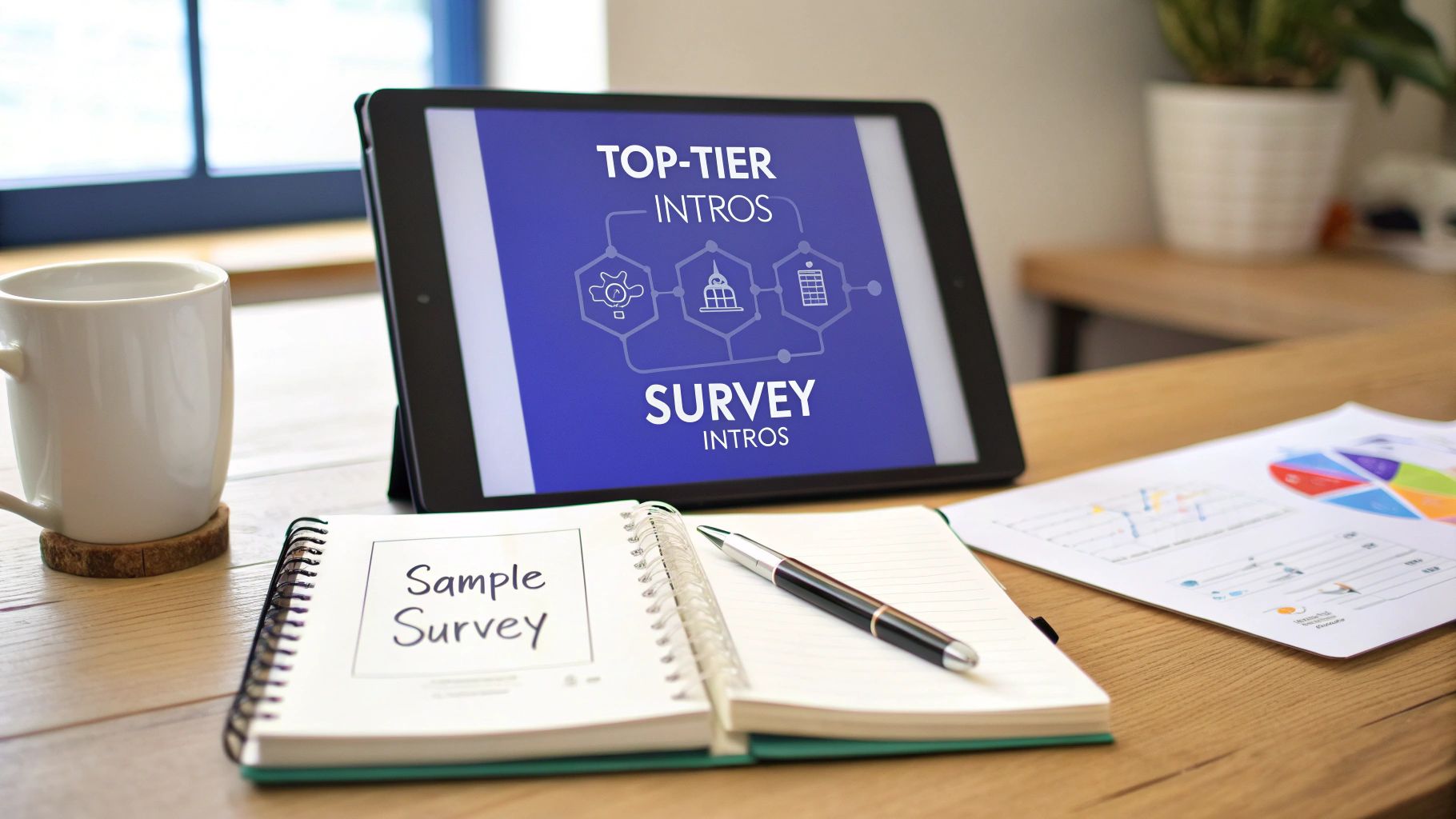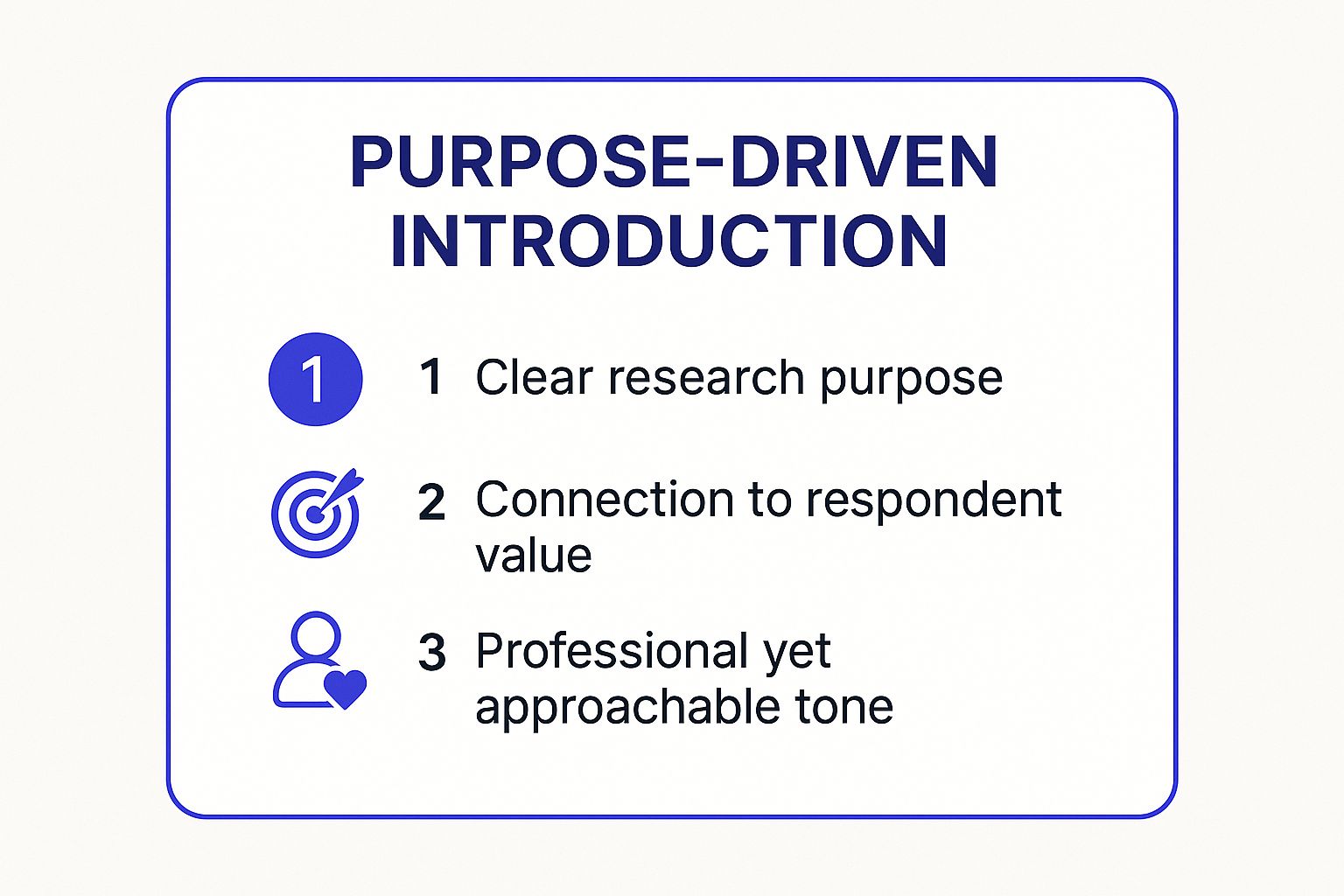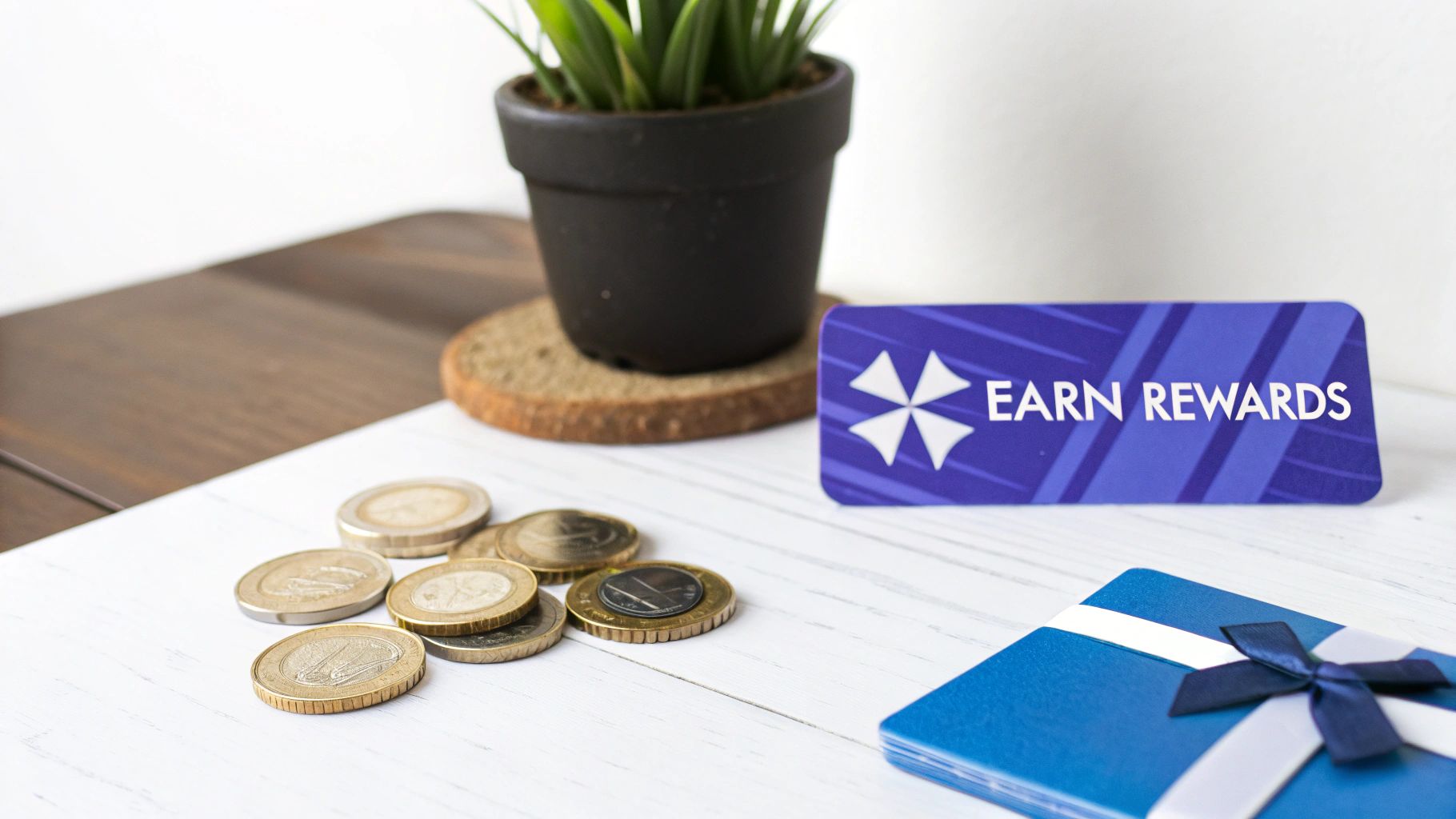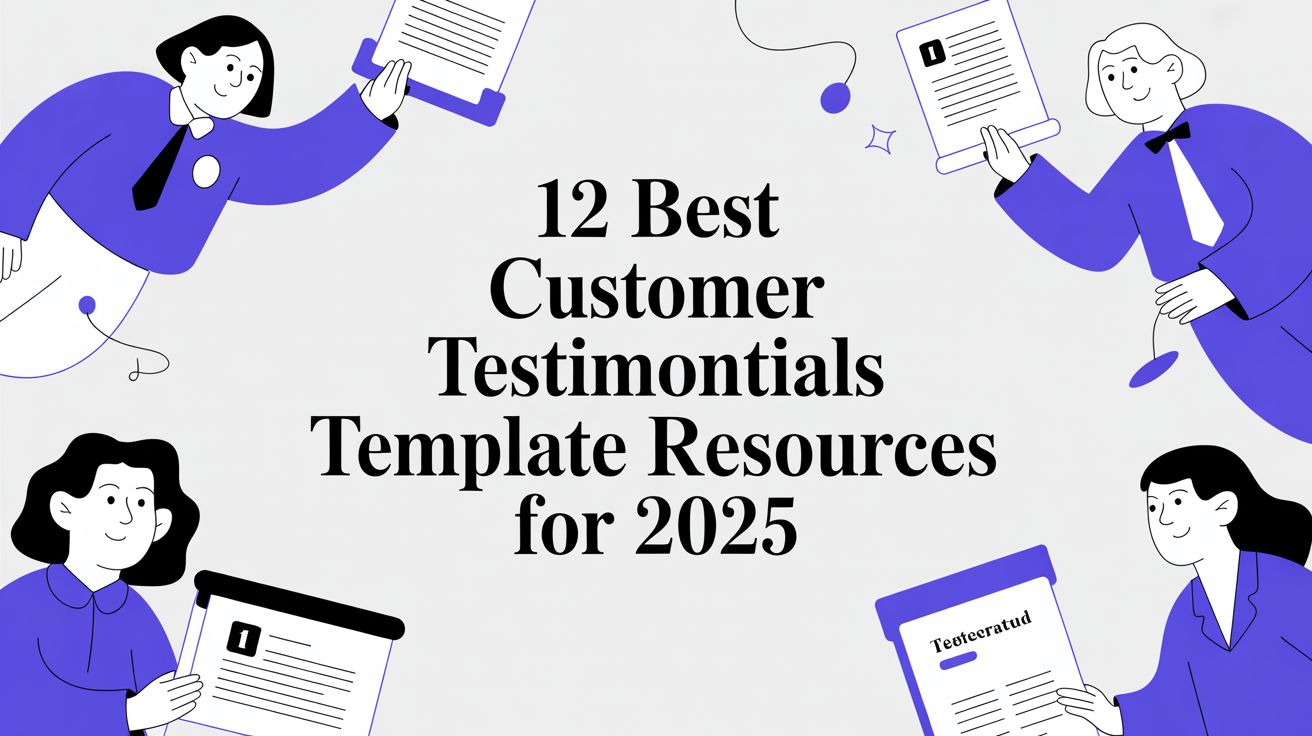6 Top-Tier Sample of Survey Introduction Ideas for 2025
Discover our curated sample of survey introduction examples. Get actionable templates to boost response rates and gather better feedback for your SaaS business.

Getting someone to start your survey is often the hardest part. The first few words determine whether a user clicks through or closes the tab. A strong opening sets clear expectations, builds trust, and convinces participants their time is well spent. A weak one gets ignored, leaving you without the data you need.
For SaaS companies, effective survey introductions are important for gathering feedback that drives product development, reduces churn, and improves customer satisfaction. This guide presents six distinct strategies for crafting a compelling opening. We will break down each sample of survey introduction, showing you the specific tactics behind its success and how to replicate it.
You will find practical examples and clear, actionable takeaways to help you build introductions that get responses. Whether you are measuring Net Promoter Score, investigating user friction, or validating a new feature idea, these frameworks will help you capture the insights that matter most. We'll explore introductions that lead with purpose, transparency, incentives, personalization, privacy, and authority.
1. The Purpose-Driven Introduction
The Purpose-Driven Introduction is a foundational approach that immediately answers the respondent’s first question: “Why should I care?” This technique goes beyond a simple greeting by clearly stating the survey's objective and its direct importance. By connecting the participant's feedback to a tangible outcome, it makes them feel like a valued partner in the research process, not just a data point.
This method is highly effective because it builds on a principle of mutual respect. When you explain precisely how the gathered information will be used, whether to improve a service they use or contribute to a larger body of knowledge, you establish trust. This transparency transforms the survey from a transactional request into a collaborative effort, significantly boosting completion rates and the quality of responses. It is a cornerstone for any effective sample of survey introduction.
Strategic Breakdown
- Clarity is Key: Vague statements like "help us improve" are less effective than specific ones. A customer satisfaction survey, for example, should state, "Your feedback will directly influence the features we prioritize in our Q3 software update."
- Connect to Value: Frame the purpose in a way that aligns with the respondent’s interests. For an employee engagement survey, showing a commitment to improving workplace culture gives staff a personal stake in the outcome.
- Establish Credibility: This approach is popularized by research giants like Gallup and the Pew Research Center because it grounds the survey in professionalism and legitimacy. Mentioning your organization's commitment to the stated purpose reinforces this.
The following infographic highlights the three core elements that make a Purpose-Driven introduction successful.

This visual summary shows how a clear purpose, a connection to respondent value, and a professional tone work together to create an effective introduction.
Actionable Takeaways
To implement this method, start by drafting a single, compelling sentence that encapsulates your survey's goal. Then, build your introduction around it.
Pro-Tip: Test your purpose statement. Ask a colleague if it's clear and motivating. If they have to ask follow-up questions about the "why," refine it until the purpose is self-evident.
For SaaS companies, this approach is perfect for post-onboarding feedback, feature-request surveys, and annual customer satisfaction reviews. It frames the interaction as part of an ongoing partnership dedicated to building a better product for the user.
2. The Time-Commitment Transparent Introduction
The Time-Commitment Transparent Introduction directly addresses a respondent's most practical concern: “How long will this take?” This method builds immediate goodwill by respecting the participant's time, setting clear expectations from the very beginning. By stating the estimated completion time or the number of questions, you remove uncertainty, which is a major cause of survey abandonment.

This approach is effective because it frames the survey as a manageable task rather than an open-ended commitment. It helps potential respondents make an informed decision to participate, significantly improving engagement and completion rates. When a user sees a "quick 3-minute survey," they can fit it into their schedule, making this a powerful technique for any sample of survey introduction. The transparency shows respect, which is fundamental to collecting quality feedback. To better understand how this affects participation, you can explore survey response rate benchmarks to see the impact of small optimizations.
Strategic Breakdown
- Provide Realistic Estimates: Underpromising on time and over-delivering on length will frustrate users and damage trust. Time your survey with a few test participants to get an accurate average. For example, "This survey includes 15 questions and should take about 10 minutes."
- Use a Range: If completion times vary, provide a range. A statement like "This will take between 5-7 minutes" is more honest and credible than a single, potentially inaccurate number.
- Mention Progress Indicators: If your survey tool includes a progress bar, mention it. "You can see your progress at the bottom of the screen" lets respondents know they can track their advancement, reducing the feeling of being stuck in a long process. This method is heavily advocated in best practices from platforms like SurveyMonkey and Qualtrics.
The following infographic highlights the three core elements that make a Time-Commitment Transparent introduction successful.
This visual summary shows how a clear time estimate, a realistic scope, and a mention of progress tracking work together to create an effective introduction.
Actionable Takeaways
To use this method, first calculate the average time it takes to complete your survey. Then, prominently display this information at the very top of your introduction.
Pro-Tip: Account for different devices. A survey that takes 5 minutes on a desktop with a full keyboard might take longer on a mobile device. If your audience is primarily mobile, test on those devices and adjust your time estimate accordingly.
For SaaS companies, this technique is ideal for quick pulse surveys, post-support ticket feedback, and net promoter score (NPS) questions. It reassures busy professionals that providing feedback will not be a significant disruption to their day, making them more likely to respond.
3. The Incentive-Focused Introduction
The Incentive-Focused Introduction directly addresses a respondent's practical motivation: "What's in it for me?" This approach leads with or prominently features a tangible reward for completing the survey, such as a gift card, discount, or exclusive content. It operates on a simple principle of reciprocity, offering a clear value exchange for the participant's time and effort.
This method is highly effective for reaching broader, less inherently motivated audiences or for longer, more involved surveys. While a strong purpose is always important, a well-chosen incentive can be the deciding factor that pushes a potential respondent to participate. This type of sample of survey introduction works by immediately establishing a transactional benefit, which can significantly increase response rates, particularly in competitive market research environments.

Strategic Breakdown
- Match Value to Effort: The incentive should be proportional to the survey's length and difficulty. A quick two-minute survey might warrant a 10% discount code, whereas a 30-minute B2B industry survey might justify a comprehensive benchmark report or a higher-value gift card.
- Confirm Incentive Relevance: The best incentives resonate with your specific audience. A SaaS company might offer a month of a premium feature, while a consumer brand could provide a popular gift card. The goal is to offer something the recipient genuinely wants.
- Maintain Transparency: Clearly state what the incentive is, how it will be delivered, and when the respondent can expect to receive it. Vague promises like "a chance to win" are less effective than guaranteed rewards. This clarity builds trust and manages expectations.
This visual summary shows how a relevant offer, a connection to respondent effort, and transparent terms combine to create a compelling incentive.
Actionable Takeaways
To implement this method, first decide on an incentive that provides real value to your target demographic. Then, build your introduction to feature this offer prominently, often in the very first sentence.
Pro-Tip: Be cautious of potential response bias. If the incentive is too high or attracts people interested only in the reward, it might skew your data. Balance the incentive's appeal with a clear statement of the survey's purpose to attract genuine participants.
For B2B SaaS companies, offering valuable industry reports or benchmarking data in exchange for feedback is a powerful strategy. It positions your company as a thought leader while providing a compelling reason for busy professionals to participate in your research.
4. The Personalized/Relationship-Based Introduction
The Personalized/Relationship-Based Introduction transforms a generic request into a personal conversation. This method leverages an existing connection with the respondent by referencing shared experiences, previous interactions, or specific personal details. It builds on the principles of relationship marketing to create a sense of familiarity and trust right from the start, making the recipient feel recognized and valued as an individual.
This approach is powerful because it cuts through the noise of impersonal mass communication. When a survey acknowledges a recent purchase, a specific service interaction, or a shared history (like a graduation year), it signals that the request is not random. This level of detail makes the survey feel more relevant and shows that you have done your homework, which can dramatically increase response rates and the thoughtfulness of the answers provided. It is an excellent example of a sample of survey introduction that prioritizes connection.
Strategic Breakdown
- Leverage Specific Data: Generic personalization like "[First Name]" is a start, but true impact comes from specifics. A survey for a SaaS customer could mention, "Following your recent use of our new reporting feature..." This shows you are paying attention.
- Maintain a Professional Tone: Personalization should not become overly familiar or casual. The goal is to build rapport, not to blur professional boundaries. The tone should remain respectful while acknowledging the existing relationship.
- Verify Information: The biggest risk of this approach is using incorrect data. A survey that references the wrong product or a non-existent interaction can destroy trust instantly. Always check that your personalization tokens and CRM data are accurate.
This strategy is a cornerstone for companies that prioritize customer relationships, such as those using CRM platforms like Salesforce or email marketing tools like Mailchimp, to manage and deepen customer connections.
Actionable Takeaways
To use this method effectively, segment your audience based on specific interactions or data points. Draft introduction templates for each segment that incorporate unique personalization fields.
Pro-Tip: Balance personalization with privacy. Only use information the respondent has willingly shared with you and would expect you to know. For example, referencing a support ticket is appropriate, but mentioning their location data without context could feel intrusive.
This introduction is ideal for SaaS companies aiming to gather feedback at key customer journey moments. It works exceptionally well for post-interaction surveys, such as those following a customer onboarding process. By referencing the recent onboarding experience, you make the feedback request timely and highly relevant. To refine this part of your customer lifecycle, you can explore effective customer onboarding strategies that create opportunities for meaningful, personalized follow-up.
5. The Confidentiality and Privacy-Assured Introduction
The Confidentiality and Privacy-Assured Introduction directly confronts respondent apprehension about data security. This technique leads with explicit assurances about data protection, anonymity, and privacy, making it clear that their personal information is safe. By proactively addressing these concerns, you build immediate trust, which is vital when asking for sensitive or personal feedback.
This method is effective because it removes a significant barrier to participation. When respondents feel secure, they are more likely to provide honest, unfiltered answers, especially on topics like personal health, financial status, or internal workplace issues. This approach transforms the survey from a potentially intrusive request into a secure dialogue, improving both response rates and data integrity. It is an indispensable sample of survey introduction for any research involving sensitive information.
Strategic Breakdown
- Be Specific and Transparent: Vague promises like "your data is safe" are insufficient. Instead, state exactly how data is protected. For instance, an employee survey should clarify, "Your individual responses are anonymous and will be aggregated with others; management will only see summarized group results."
- Cite Compliance and Authority: Referencing established standards adds weight to your claims. Mentioning HIPAA compliance for healthcare surveys or IRB (Institutional Review Board) approval for academic studies provides a verifiable layer of assurance.
- Keep It Accessible: Avoid dense legal jargon. The goal is to reassure, not to confuse. Translate complex privacy policies into simple, clear statements that a layperson can easily understand.
The following infographic highlights the three core elements that make a Confidentiality and Privacy-Assured introduction successful.
This visual summary shows how specific assurances, credible compliance, and clear language combine to create a trustworthy introduction.
Actionable Takeaways
To use this method, identify the primary privacy concern your audience might have and address it head-on in your opening sentences. Make your commitment to confidentiality the first thing they read.
Pro-Tip: Include a link to your full privacy policy but summarize the key points directly in the introduction. This provides transparency for those who want details without overwhelming the average respondent.
For organizations handling personal data, this introduction is non-negotiable. It's ideal for HR departments conducting workplace climate surveys, healthcare providers gathering patient feedback, and financial institutions assessing customer security sentiment. For a deeper look at the technical and ethical considerations, you can create anonymous surveys on Surva.ai.
6. The Authority and Credibility-Establishing Introduction
The Authority and Credibility-Establishing Introduction leverages trust as its primary motivator. This approach immediately showcases institutional backing, expert endorsement, or official credentials to assure respondents of the survey's legitimacy and importance. By leading with a recognized name or affiliation, you tap into pre-existing trust and respect, encouraging participants to view the survey as a serious and worthwhile endeavor.
This method works because it directly addresses a key psychological barrier: skepticism. Respondents are often wary of sharing information with unknown entities. Presenting verifiable credentials, such as a university affiliation or a government seal, removes this doubt. It frames the request within a context of professional research or official data collection, making respondents feel more secure and their contributions more significant. This is a powerful sample of survey introduction for building instant rapport.
Strategic Breakdown
- Display Credentials Prominently: Visual cues are important. A university logo, an official government seal, or an industry association’s branding should be visible at the top of the introduction. This visual anchor immediately sets a professional tone.
- Balance Authority with Approachability: While credentials establish legitimacy, the tone should remain respectful and inviting. Avoid overly academic or bureaucratic language that might intimidate the respondent. The goal is to be credible, not condescending.
- Provide Verification: Legitimacy is built on transparency. Include a clear contact email or a link to an official project page where respondents can verify the survey's authenticity. This small step can significantly boost confidence and participation.
This strategy is frequently used by academic research institutions, government bodies like the U.S. Census Bureau, and major market research firms. They understand that their established reputation is a valuable asset in data collection.
Actionable Takeaways
To effectively use this method, place your most powerful credential front and center. Your opening line should introduce your organization and its connection to the research.
Pro-Tip: Check that the authority you cite is directly relevant to the survey's topic. A healthcare survey gains more credibility from a medical institution's backing than from a generic corporate sponsor. The connection must be logical and clear to the respondent.
For SaaS companies partnering with a well-known research firm or a university for a joint study, this introduction is ideal. It borrows credibility from the partner institution, elevating the perceived importance of the survey and encouraging higher-quality, more thoughtful responses from users.
Survey Introduction Comparison Matrix
Putting These Introductions Into Action
Throughout this article, we have explored a diverse collection of sample survey introduction examples, each designed for a specific strategic purpose. We moved beyond simple templates to dissect what makes them effective. From the transparent time commitment to the authority-establishing intro, the core lesson is clear: your survey's opening lines are your most valuable asset in gathering high-quality user feedback.
A thoughtfully constructed introduction does more than just ask for a moment of a user's time. It sets the stage, manages expectations, and builds the initial trust required for honest, detailed responses. The most effective survey introductions are rarely one-dimensional; they are strategic hybrids.
Synthesizing for Maximum Impact
Think of the six approaches we covered as ingredients for a powerful recipe. You are the chef, and your audience's palate dictates the final combination.
- A Purpose-Driven opening can be combined with Time-Commitment Transparency to show users why their feedback matters and exactly what it will cost them in minutes.
- An Incentive-Focused introduction gains more power when paired with a Personalized greeting, making the offer feel less transactional and more like a genuine thank you.
- For sensitive topics like churn or pricing feedback, a Confidentiality-Assured statement is a necessity. Combining it with an Authority-Establishing line can reassure users that their private feedback is going to the right people who can enact change.
The key is to layer these elements based on your specific goal and your relationship with the user segment you are targeting. A brand new trial user requires a different approach than a power user who has been with you for years. Your ability to select and blend the right components will directly influence your response rates and the quality of the data you collect.
From Theory to Actionable Strategy
Mastering the art of the survey introduction gives you a direct line to the user insights that fuel growth. A great opening turns a routine request into a meaningful conversation, paving the way for feedback that can validate a product roadmap, reduce customer churn, or uncover new market opportunities. The difference between a survey that gets ignored and one that yields game-changing data often comes down to the first few sentences.
As you move forward, challenge yourself to A/B test different introduction styles. Does your audience respond better to a direct, incentive-led approach or a softer, relationship-based opening? Answering this question is a powerful insight in itself. Every sample of survey introduction we've reviewed serves as a starting point. Your next step is to adapt, test, and refine them to build a feedback engine that continuously delivers value.
Ready to stop guessing and start building surveys that get results? Surva.ai provides the tools to craft, test, and deploy strategically powerful survey introductions like the ones we've covered. Use our platform to trigger surveys based on user behavior and automate the entire feedback loop. Start your free trial of Surva.ai today and turn your user feedback into your biggest growth lever.


